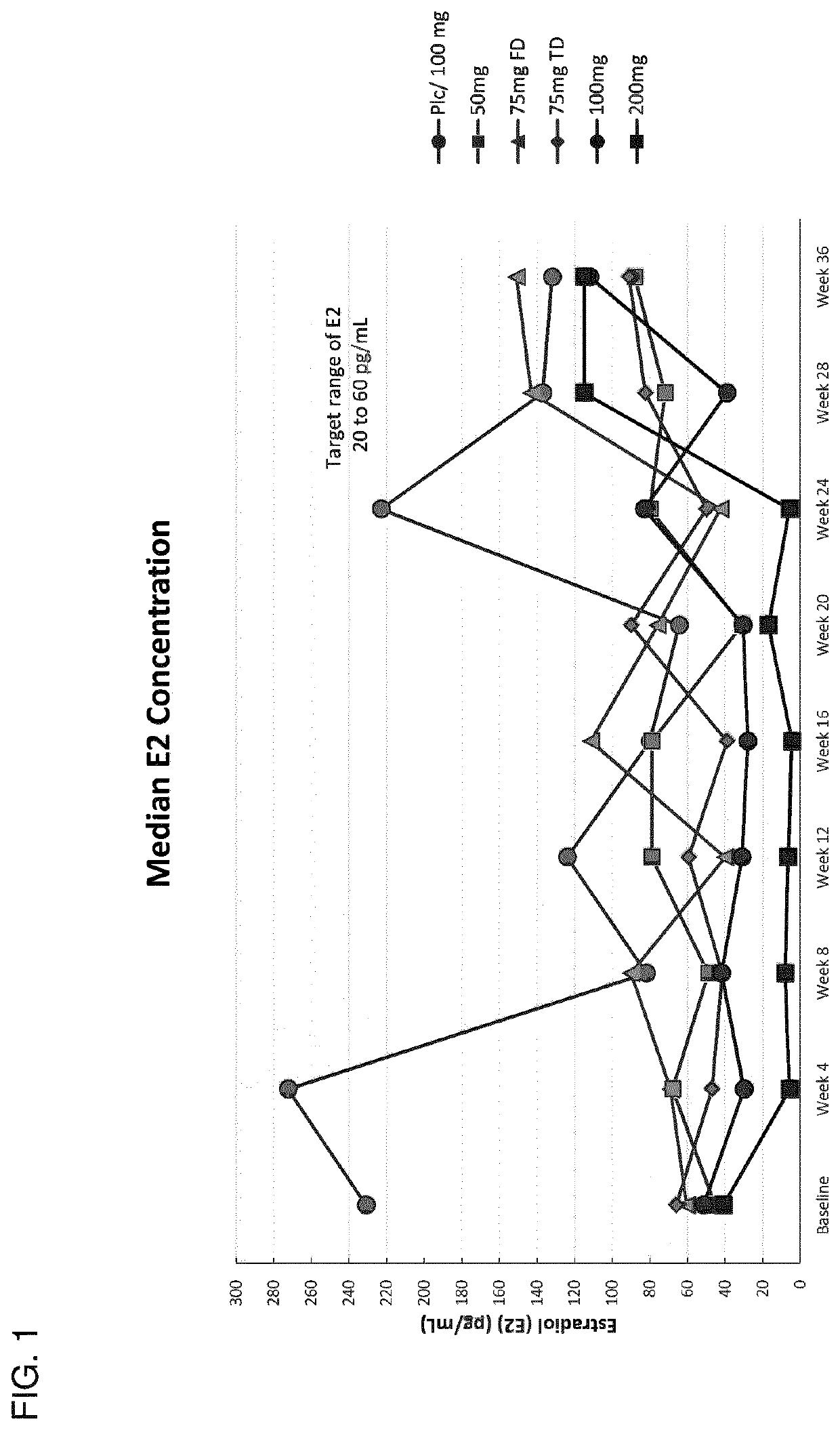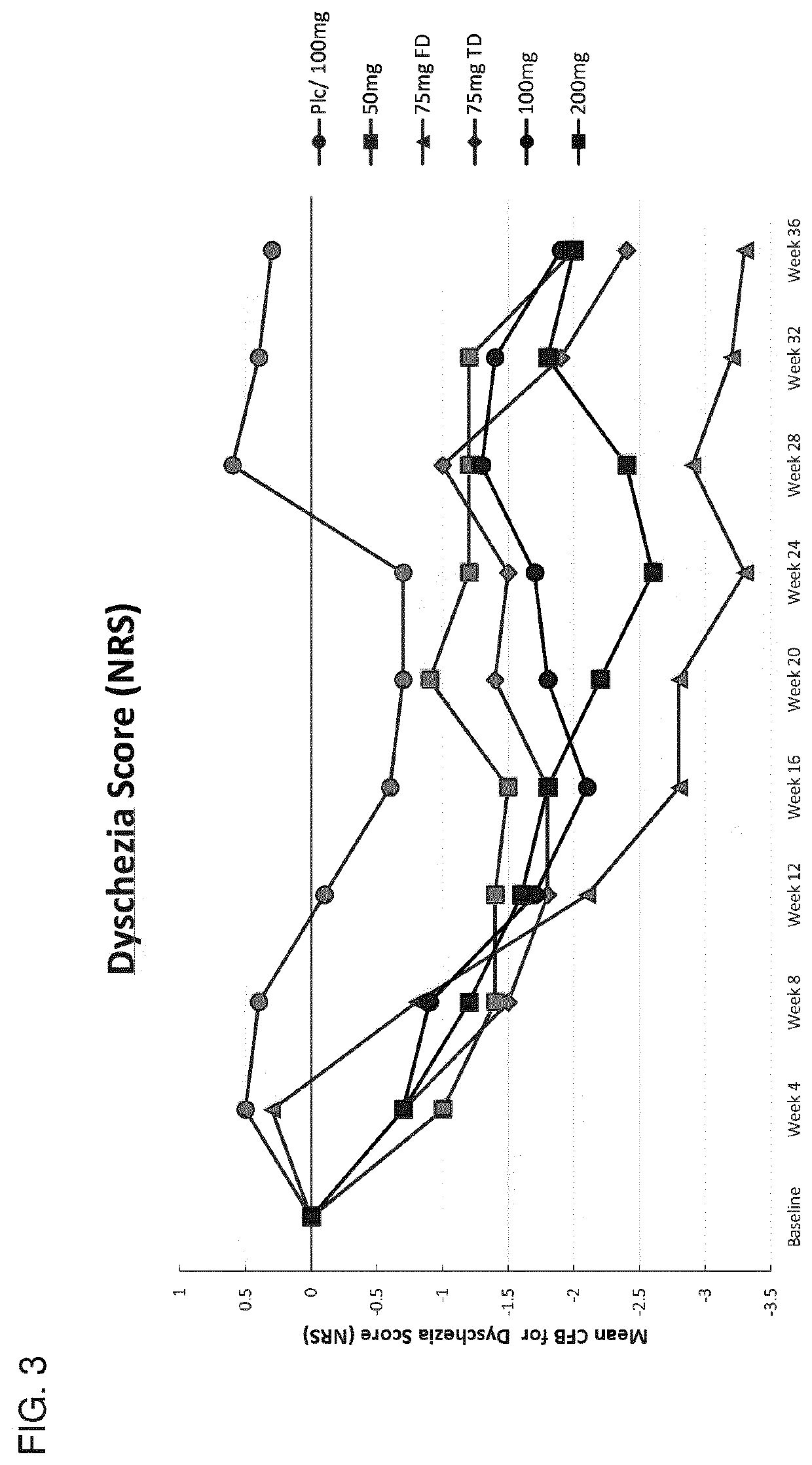Compositions and methods for the treatment of estrogen-dependent disorders
a technology of estrogen-dependent disorders and compositions, applied in drug compositions, sexual disorders, extracellular fluid disorders, etc., can solve the problems of bone mineral density loss, excessive suppression of endogenous e2, and harmful side effects
- Summary
- Abstract
- Description
- Claims
- Application Information
AI Technical Summary
Benefits of technology
Problems solved by technology
Method used
Image
Examples
example 1
ation of a GnRH Antagonist Effectuates a Sustained Alleviation of Estrogen-Dependent Disease Symptoms Even after Treatment is Halted
Methods
[0735]This example describes the results of a Phase 2b human clinical trial undertaken to evaluate the efficacy of a GnRH antagonist represented by formula (VI) in a series of patients suffering from an estrogen-dependent disease. In this trial, a series of human female patients diagnosed as having endometriosis were administered the choline salt of 3-[2-fluoro-5-(2,3-difluoro-6-methoxybenzyloxy)4-methoxyphenyl]-2,4-dioxo-1,2,3,4-tetrahydrothieno [3,4d]pyrimidine-5-carboxylic acid periodically over the course of a 24-week treatment period. After 24 weeks of treatment, various patients entered a 24-week post-treatment follow-up period during which the patients were monitored for serum β17-estradiol (E2) concentration, severity of disease symptoms, and bone mineral density.
Results
[0736]A series of n=328 human female patients having clinically-diagn...
example 2
GnRH Antagonist for the Treatment of a Patient Having Uterine Fibroids or Endometriosis
[0741]Using the compositions and methods described herein, a patient may be administered a GnRH antagonist so as to treat, and / or ameliorate the symptoms of, uterine fibroids or endometriosis, among other estrogen-dependent diseases. The GnRH antagonist (e.g., a compound of formula (I), above, such as compound (VI) or the choline salt thereof) may be administered to the patient in an amount sufficient to reduce the serum concentration of LH, FSH, and / or E2 in circulation. The GnRH antagonist may be administered, for example, in an amount of from about 25 mg to about 500 mg per dose. Exemplary doses of the GnRH antagonist include, without limitation, an amount of from 25 mg to 500 mg, 30 mg to 495 mg, 35 mg to 490 mg, 40 mg to 485 mg, 45 mg to 480 mg, 50 mg to 475 mg, 55 mg to 470 mg, 60 mg to 465 mg, 65 mg to 460 mg, 70 mg to 455 mg, 75 mg to 450 mg, 80 mg to 445 mg, 85 mg to 440 mg, 90 mg to 435 ...
example 3
GnRH Antagonist for the Treatment of a Patient Having Adenomyosis
[0745]This examples describes the results of a human clinical trial conducted to evaluate the ability of a GnRH antagonist, 3-[2-fluoro-5-(2,3-difluoro-6-methoxybenzyloxy)4-methoxyphenyl]-2,4-dioxo-1,2,3,4-tetrahydrothieno [3,4d]pyrimidine-5-carboxylic acid (represented by formula (VI)), or a pharmaceutically acceptable salt thereof, to treat adenomyosis, an estrogen-dependent disease, in human patients diagnosed as having this condition.
[0746]One aim of this study was to investigate the ability of the GnRH antagonist to maintain its therapeutic effects despite being administered to patients in a progressively lower dosage throughout the trial. To this end, the patients treated in this study was first administered the GnRH antagonist of formula (VI) in an amount of 200 mg / day during an initial 12-week period. The GnRH antagonist was then administered to the patients in a reduced amount of 100 mg / day during a subsequent...
PUM
| Property | Measurement | Unit |
|---|---|---|
| time | aaaaa | aaaaa |
| 2θ | aaaaa | aaaaa |
| 2θ | aaaaa | aaaaa |
Abstract
Description
Claims
Application Information
 Login to View More
Login to View More - R&D
- Intellectual Property
- Life Sciences
- Materials
- Tech Scout
- Unparalleled Data Quality
- Higher Quality Content
- 60% Fewer Hallucinations
Browse by: Latest US Patents, China's latest patents, Technical Efficacy Thesaurus, Application Domain, Technology Topic, Popular Technical Reports.
© 2025 PatSnap. All rights reserved.Legal|Privacy policy|Modern Slavery Act Transparency Statement|Sitemap|About US| Contact US: help@patsnap.com



